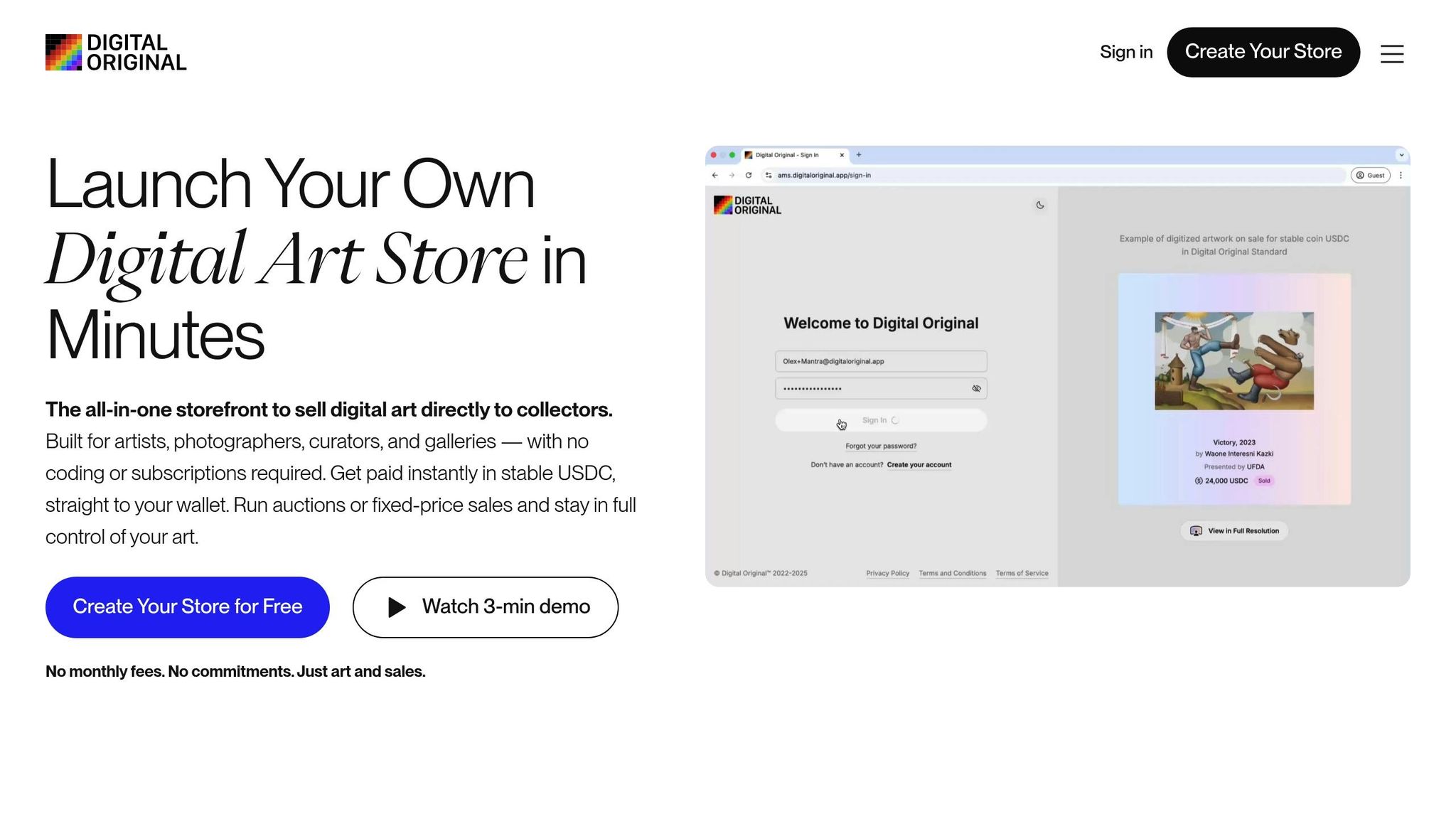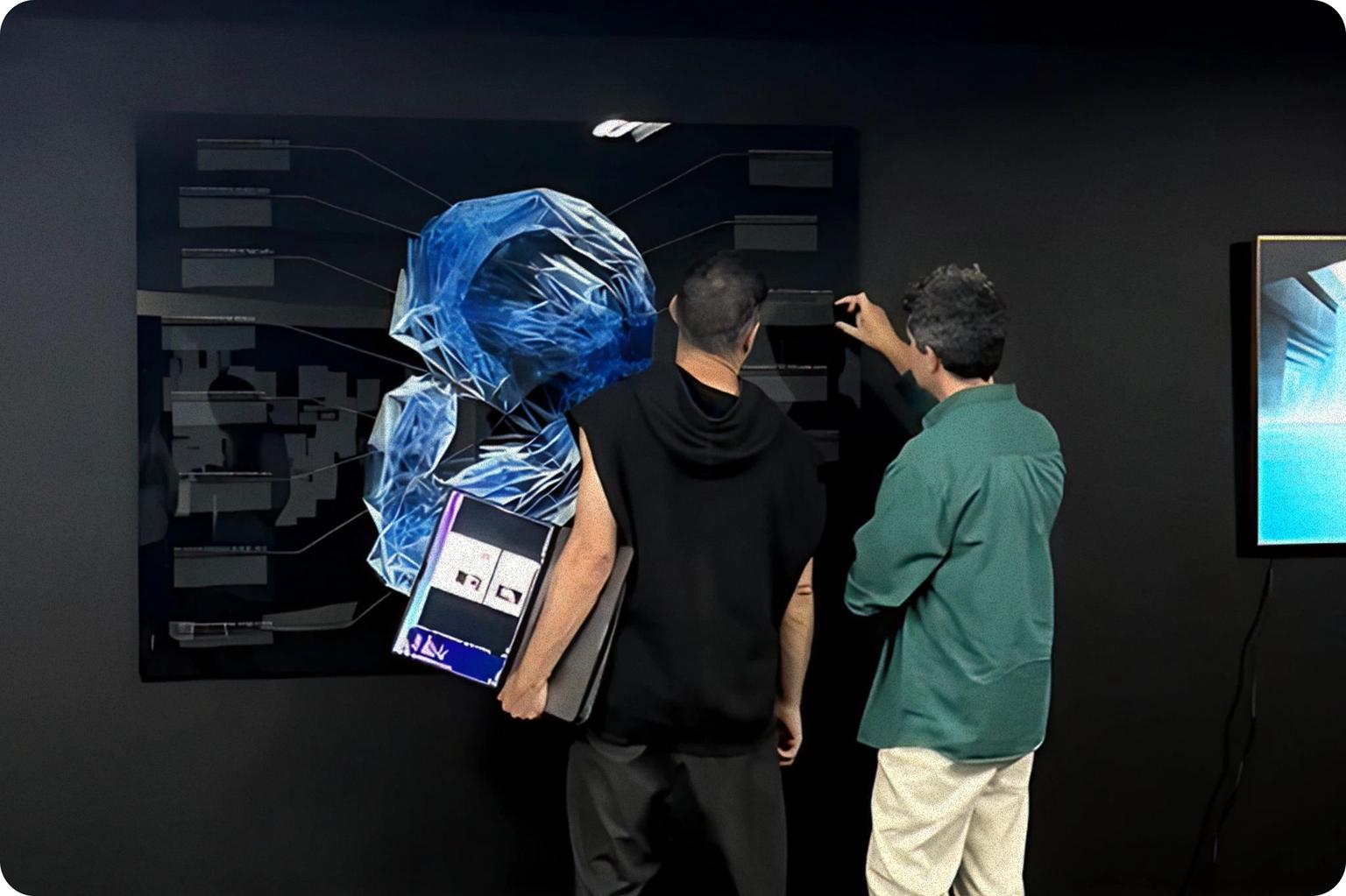Galleries Going Digital: Trends, Tools, and Tactics for 2025
In 2025, art galleries are transforming to meet the demands of a digital-first world. Collectors now expect online access to artwork, secure blockchain-backed ownership records, and seamless purchasing experiences. Rising costs and declining foot traffic in physical spaces are pushing galleries to expand their reach globally through digital platforms. Tools like Virtual Reality (VR), Artificial Intelligence (AI), and blockchain are reshaping how art is experienced, bought, and sold.
Key takeaways for galleries:
- Online Presence is Non-Negotiable: Buyers want 24/7 access to high-quality images, provenance details, and mobile-friendly purchasing options.
- Blockchain is a Must-Have: Ensures secure ownership, automates artist royalties, and enables fractional ownership.
- VR/AR and AI Tools: Enhance the buyer experience with virtual exhibitions, tailored recommendations, and efficient inventory management.
- Economic Benefits: Lower overhead costs and global reach make digital strategies more attractive.
Solutions like DigitalOriginal.app simplify this shift by offering easy-to-use tools for creating online galleries, managing transactions with smart contracts, and connecting with collectors worldwide. Galleries that embrace these changes are better positioned to thrive in the evolving art market.
The Future of Digital Art, Galleries, and Community Building for Artists w/P1A | S9 E1
Why Galleries Are Going Digital in 2025
The art world is undergoing a major transformation, and galleries that fail to embrace digital tools risk losing out on new revenue streams. Three key factors are driving this shift, fundamentally changing how art is bought and sold. Let’s explore how these forces are reshaping the gallery experience.
Changing Collector Expectations
Millennials and Gen Z are quickly becoming the dominant force in the art market, and their buying habits differ significantly from those of older generations. These younger collectors expect fast, seamless online transactions that are transparent and accessible.
They want 24/7 access to galleries, complete with high-quality images, detailed provenance, and mobile-friendly purchasing options. Many browse and buy art during their daily routines - on commutes, during breaks, or while traveling - and prefer to handle the entire process on their smartphones, from discovery to payment.
Security is also a top concern. With the rise of blockchain technology, these buyers expect digital certificates of authenticity and transparent ownership records. Galleries that rely on outdated methods, like paper certificates or verbal assurances, risk being seen as less secure and trustworthy.
Economic Opportunities and Global Reach
Operating a physical gallery has become increasingly expensive, especially in cities like New York, Los Angeles, and Miami, where real estate prices are soaring. At the same time, foot traffic in traditional gallery districts has been declining, making it harder to justify the costs of maintaining a physical space.
Going digital allows galleries to overcome these challenges. A gallery in a smaller market, like Kansas City, can now sell artwork to collectors in cities across the globe - whether in Singapore, Dubai, or São Paulo. By expanding beyond local buyers, galleries can reach millions of potential customers without the overhead costs of maintaining a physical location.
Digital sales also improve profit margins. Without expenses like rent, utilities, and on-site staff, galleries can redirect those savings into acquiring better artwork, improving their online platforms, or boosting their marketing efforts. Additionally, new revenue models - such as paid memberships, exclusive online previews, and virtual private viewings - are gaining traction, creating recurring revenue streams for galleries.
Blockchain and Verified Ownership
Blockchain technology is addressing some of the art world’s oldest problems, like proving authenticity and ownership. The industry has long struggled with forgeries and disputes over provenance, but blockchain provides a secure, unchangeable record of a piece’s history, reducing the risk of fraud.
Smart contracts, powered by blockchain, can also automate royalty payments to artists each time their work is resold. This ensures artists continue to earn income from their creations while building trust with collectors.
Additionally, blockchain transparency reduces legal uncertainties that have traditionally made some buyers hesitant. With clear, verifiable ownership records, collectors can purchase art with greater confidence, knowing disputes are less likely to arise.
Another exciting development is the concept of fractional ownership. Blockchain makes it possible for multiple collectors to own shares of high-value artwork, making expensive pieces more accessible. For galleries, facilitating these arrangements opens up entirely new revenue streams.
Key Digital Trends Shaping Art Galleries in 2025
As art galleries navigate evolving collector expectations and financial challenges, digital trends are reshaping how they operate and connect with audiences. These advancements are revolutionizing the way art is experienced, while also streamlining gallery operations. For galleries aiming to remain competitive in today’s tech-driven world, understanding these trends is a must.
3D and VR/AR Experiences
Virtual Reality (VR) and Augmented Reality (AR) are opening up entirely new ways for people to engage with art. These tools allow visitors to explore virtual gallery spaces, zoom in on intricate artwork details, and even interact with pieces in ways that a physical visit might not allow.
With VR headsets becoming more affordable and AR accessible via smartphones, these technologies are no longer out of reach for the average collector. Features like 3D scanning enable the creation of digital twins of both galleries and artworks, allowing collectors to preview how a piece would look in their own space through AR. This "try before you buy" method can ease purchasing decisions and reduce returns.
On top of that, AI is stepping in to further enhance gallery operations and the collector experience.
AI-Powered Tools for Curation and Sales
Artificial Intelligence is changing the game by offering personalized and efficient solutions. By analyzing browsing behavior and past purchases, AI can recommend tailored art collections to potential buyers. It also helps galleries set smarter prices with predictive pricing models that consider market trends, artist trajectories, and comparable sales.
AI-powered image recognition tools simplify inventory management by automatically tagging and categorizing artworks. This makes it easier for galleries to track, locate, and organize their collections with minimal effort.
Hybrid Physical and Digital Art Practices
The boundary between physical and digital art is becoming increasingly fluid, creating exciting opportunities for galleries to attract modern collectors. Hybrid exhibitions combine traditional pieces with digital displays, interactive installations, or AR features, while digital screens can rotate through multiple artworks, maximizing the use of limited physical space.
Digital exhibitions also come with practical benefits. They cut down on shipping and travel requirements, reducing environmental impact. High-resolution imaging and 3D scanning enable remote authentication and documentation, giving collectors the confidence to buy from anywhere. This eliminates geographical barriers, allowing galleries to reach a global audience without requiring in-person visits.
These trends are not just reshaping how art is displayed and sold - they’re redefining the entire gallery experience, making it more accessible, personalized, and sustainable.
sbb-itb-4e84554
How Galleries Can Use DigitalOriginal.app for Success

The art world is rapidly evolving, with digital trends opening up new opportunities for galleries willing to adapt. DigitalOriginal.app steps in as a practical solution, offering tools that help galleries navigate the digital shift without getting bogged down by technical hurdles. Its features are designed to level the playing field, enabling galleries to compete effectively in today’s market.
Launch a Custom Digital Gallery Website
Building a professional online presence no longer requires a team of developers or coding know-how. DigitalOriginal.app simplifies the process with a user-friendly drag-and-drop interface, allowing galleries to create polished storefronts that look great and function seamlessly. The solution ensures these storefronts are optimized for both desktop and mobile, so collectors can browse and buy whether they’re on a smartphone during their morning commute or relaxing at home with a tablet. This accessibility helps galleries overcome the constraints of physical spaces.
Another standout feature is the access control options, which give galleries the freedom to tailor how they present their collections. Through the storefront builder and smart contract sales, galleries can reach collectors across several countries, achieve instant payouts for sold pieces, and manage royalties effortlessly.
Sell Art with Built-in Smart Contracts
Creating a digital storefront is just the beginning - secure and efficient transactions are equally important. Traditional art sales often involve drawn-out payment processes, stacks of paperwork, and unclear ownership transfers. DigitalOriginal.app eliminates these pain points with integrated smart contracts that automate transactions. Each sale includes verified ownership transfer and instant USDC payouts, ensuring galleries get paid immediately instead of waiting days or even weeks.
For galleries working with living artists, the automated royalty system is a game-changer. When a piece resells on the secondary market, the smart contract automatically distributes the agreed-upon royalties to both the artist and the gallery. This feature creates a steady stream of income that traditional sales methods often overlook, helping to build sustainable business models.
With online art sales now making up about 25% of the global art market, galleries that offer secure and transparent transactions gain a major edge. The USDC payment system also simplifies international sales, removing the usual barriers of cross-border transactions.
Streamline Art Management and Collector Relations
Even with secure, instant transactions in place, managing inventory and maintaining strong relationships with collectors remain crucial. As galleries expand their digital presence, these tasks can become increasingly complex. DigitalOriginal.app tackles these challenges head-on with integrated tools that streamline both operations and client interactions.
Additionally, it includes direct communication tools, eliminating the need for separate email or customer relationship management systems. Galleries can handle collector inquiries, share additional details about artworks, and nurture relationships - all within the same system they use to manage sales. This integration not only saves time but also ensures no communication slips through the cracks.
DigitalOriginal.app’s flexible fee structure is another advantage, accommodating various business models. Whether a gallery prefers commission-based sales, subscriptions, or flat fees, the solution adapts to their needs. For galleries just starting their digital journey, the free plan offers full functionality with a 5-15% fee per sale, so they only pay when they make a sale.
Pros and Cons of Digital Transformation for Art Galleries
Digital transformation is reshaping how art galleries operate, presenting both opportunities and challenges. While it opens doors to broader audiences and streamlines operations, it also requires galleries to adapt to new technologies and marketing strategies.
By going digital, galleries can tap into a global audience, benefit from instant USDC payouts to improve cash flow, and utilize smart contracts for automated royalty tracking. On the flip side, this shift demands new skills, expertise in digital marketing, and a strong focus on cybersecurity.
Comparison Table of Pros and Cons
| Advantages | Challenges |
|---|---|
| Global reach – Connect with collectors worldwide, beyond local visitors | Learning curve – Staff need training to use digital tools effectively |
| Instant payments – USDC payouts eliminate banking delays | Digital security – Increased risks require stronger cybersecurity measures |
| Automated royalties – Smart contracts simplify tracking and payments for secondary sales | Marketing adaptation – Online promotion requires different strategies compared to physical events |
| Lower overhead – Less reliance on expensive physical spaces and storage | Technology dependence – Platform outages or technical issues can disrupt operations |
| 24/7 availability – Buyers can browse and purchase anytime | Reduced personal touch – Building relationships through screens can feel less personal |
| Detailed analytics – Gain insights into visitor behavior, popular pieces, and sales trends | Initial setup time – Creating digital catalogs and learning platforms can be time-intensive |
| Flexible exhibitions – Easily update displays and create themed collections | Increased competition – More galleries online means vying for collector attention |
This mix of benefits and challenges underscores why many galleries find a hybrid approach to be the most effective. By combining physical spaces with digital tools, galleries can explore new opportunities while maintaining their traditional strengths.
One notable financial advantage of digital platforms is cost savings. Solutions like DigitalOriginal.app offer free plans with fees ranging from 5% to 15% per sale. Additionally, galleries can cut costs on print catalogs, shipping insurance, and physical event hosting. These savings often help offset fees, especially when reaching a larger audience.
For many galleries, gradual adoption proves to be the most practical route. Starting small - perhaps by creating a digital catalog or hosting a virtual exhibition - allows galleries to test the waters without overwhelming their teams or alienating existing clients.
Ultimately, the pace of transformation depends on each gallery's audience and goals. Galleries catering to younger, tech-savvy collectors may embrace digital strategies more quickly, while those with a traditional clientele might take a more cautious approach.
Key Takeaways
For art galleries in 2025, digital transformation isn’t just a choice - it’s a necessity for staying relevant. In 2024, 59% of collectors purchased art online, and 43% of galleries plan to prioritize online sales in 2025. With online art sales claiming a growing share of the market, galleries that resist going digital risk falling behind.
The digital art market is expanding at an impressive pace, expected to grow from $5.8 billion in 2025 to $17.72 billion by 2032, with a compound annual growth rate of 17.3%. This rapid growth opens up exciting opportunities for galleries ready to embrace digital tools and platforms.
Technology is transforming gallery operations in remarkable ways. From AI-driven curation to immersive 3D and VR/AR experiences, and blockchain-based smart contracts for verified ownership and automated royalty tracking, innovation is reshaping how galleries function and connect with audiences.
Many galleries are finding success with hybrid strategies that combine physical and digital experiences. This approach allows them to maintain close ties with local collectors while expanding their reach to global audiences through online platforms. Hybrid models create a strong foundation for adopting practical digital tools.
Solutions like DigitalOriginal.app are simplifying the shift to digital by offering user-friendly solutions. Their features include custom storefronts, built-in smart contracts, and instant USDC payouts. With a free plan and fees ranging from 5–15% per sale, galleries only incur costs when they generate revenue.
Economic challenges are also accelerating the move to digital. 75% of galleries cite economic uncertainty as a major concern. Digital platforms provide a way to diversify income, reduce reliance on local sales, and operate around the clock, helping galleries become more resilient.
Adopting digital tools does more than improve efficiency - it strengthens relationships with collectors. While there’s a learning curve, starting with intuitive platforms and gradually expanding capabilities makes the transition manageable. By integrating digital tools, galleries can enhance their operations, broaden accessibility, and create stronger connections, all while becoming more profitable.
FAQs
How can art galleries use blockchain technology to ensure secure and authentic digital art transactions?
Art galleries are turning to blockchain technology to safeguard digital art transactions and establish trust in the process. Using an immutable ledger, blockchain creates a secure and tamper-proof record of ownership and provenance, offering transparency and reliability for everyone involved.
On top of that, smart contracts built on blockchain platforms automate and validate transactions. This reduces the risks of fraud and ensures smooth ownership transfers. By tackling issues like forgery and theft, blockchain provides a dependable way to verify authenticity and trace an artwork's history.
What are the benefits of using VR and AR in digital art galleries, and how do they improve the buyer experience?
Using Virtual Reality (VR) and Augmented Reality (AR) in digital art galleries is reshaping how buyers experience and connect with art. With VR, visitors can explore galleries from anywhere in the world. It creates a realistic sense of walking through exhibitions, allowing collectors to view artworks as if they were physically present. This approach makes art more accessible to a global audience.
AR takes it a step further by blending the digital with the real world. Buyers can see how a piece of art would look in their own space, right from their phone or tablet. It also introduces interactive features, helping buyers form a stronger emotional link with the artwork. These technologies offer a tailored, immersive experience that not only keeps buyers engaged but also opens up new opportunities for sales in the expanding digital art market.
How can art galleries embrace digital platforms while keeping strong connections with collectors?
Art galleries can effectively embrace digital platforms by treating them as tools to enhance personal interactions, rather than substitutes for them. Features like virtual tours, online exhibitions, and digital communication channels enable galleries to connect with a wider audience while still preserving the unique, personal experience of in-person visits.
On top of that, digital platforms provide valuable data insights, helping galleries understand collector preferences and refine their outreach efforts. This ensures that relationships stay meaningful, whether they’re built online or face-to-face. By combining technology with a human touch, galleries can strengthen their connections and adapt seamlessly to the evolving digital art landscape.





